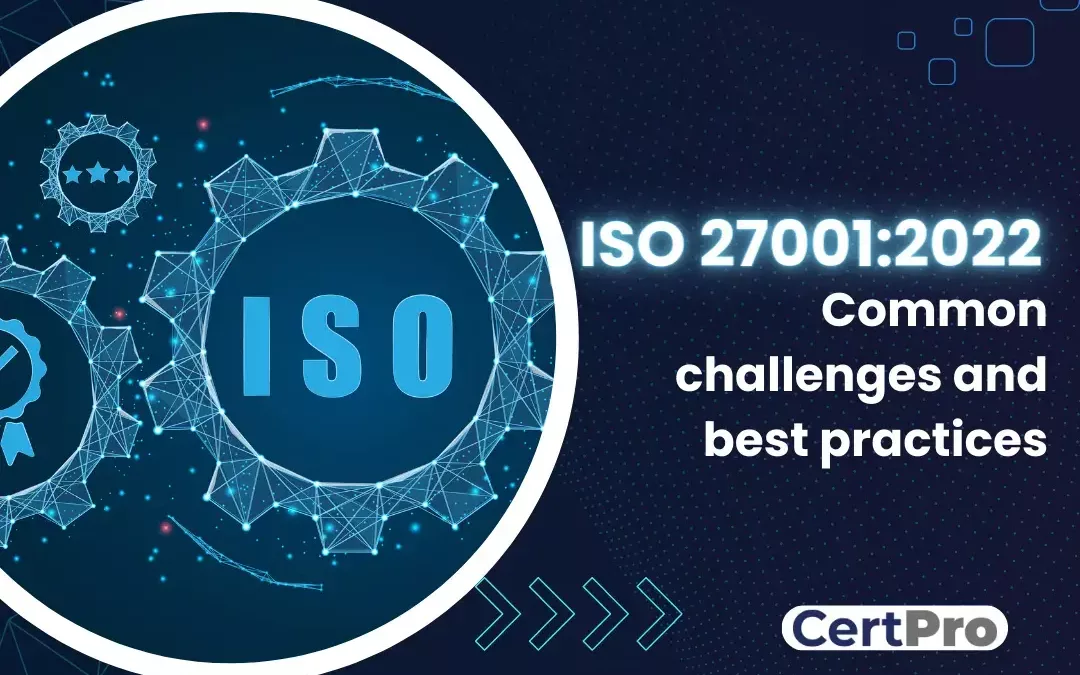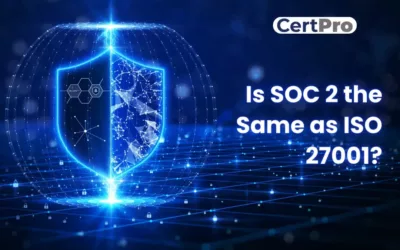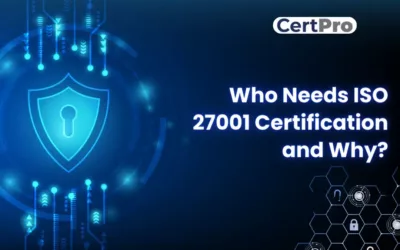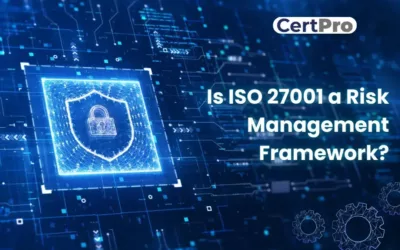In today’s digital age, information security is of paramount importance for organizations to protect their sensitive data and maintain the trust of their customers and stakeholders. It is a widely accepted standard that gives an Information Security Management System (ISMS) a systematic framework for creation, implementation, upkeep, and continuous improvement. Achieving ISO 27001:2022 certification signifies an organization’s dedication to ensuring robust information security practices. However, the certification process comes with its share of challenges.
While there could be difficulties with the certification procedure, firms can get over them by using best practices and taking a methodical approach. Organizations can effectively obtain ISO 27001:2022 certification and show their commitment to information security by securing management support, involving staff, carrying out routine risk assessments, and working with vendors.
In this article, we will explore the common challenges faced by organizations seeking ISO 27001:2022 certification and present best practices to overcome these obstacles.
ISO 27001: 2022 AND ITS BENEFITS
An internationally known information security management system (ISMS) standard is ISO 27001. It provides a systematic approach to managing sensitive company information, ensuring its confidentiality, integrity, and availability, and mitigating information security risks.
It outlines the requirements for establishing, implementing, maintaining, and continually improving an ISMS within an organization. An ISMS is a framework of policies, processes, procedures, and controls that collectively manage information risks to achieve business objectives securely.
ISO 27001:2022 benefits lie in its ability to provide a systematic and robust framework for managing information security within organizations.
The key reasons highlighting the ISO 27001:2022 benefits are:
1. Enhanced Information Security: ISO 27001:2022 benefits help organizations identify and assess information security risks systematically. By implementing the standard’s controls and measures, organizations can enhance their information security posture and protect sensitive data from unauthorized access, disclosure, alteration, and destruction.
2. Risk Management: It takes a risk-based approach to information security, which means that organizations prioritize their efforts based on the severity and likelihood of potential threats.
3. Legal and Regulatory Compliance: Many industries are subject to specific data protection and security regulations. It provides a solid foundation for organizations to meet legal and regulatory requirements related to information security.
4. Competitive Advantage: Accreditation can give firms a competitive edge. Many customers and partners now expect their vendors and service providers to demonstrate a commitment to information security.
5. Business Resilience: By identifying and addressing security risks, It helps organizations become more resilient to potential cyber-attacks or security incidents.
ISO 27001: 2022 CERTIFICATION AND HOW TO ACHIEVE IT
An organization can obtain ISO 27001 certification as proof that its Information Security Management System (ISMS) has been effectively implemented and meets the standards of ISO 27001, an international standard for information security management. To achieve this certification, an organization must establish and maintain a systematic approach to identifying information security risks, implementing appropriate controls, and continuously improving its ISMS.
This certification provides numerous benefits, including enhanced protection of sensitive information, a risk-based approach to security, legal and regulatory compliance, customer trust and confidence, and a competitive edge in the market. This certification offers numerous benefits for organizations of all sizes and industries.
Some key points to understand about the ISO 27001 certification scope are:
1. Defining the Scope: The organization needs to clearly define the boundaries of its ISMS, determining which assets and processes are included and excluded. This scope is documented in the Information Security Management System (ISMS) scope statement.
2. Risk Assessment and Treatment: The risk assessment process should cover all assets and processes within the defined scope to identify and evaluate information security risks.
3. Applicability to Business Functions: The organization should ensure that the scope of certification aligns with its business functions and activities. It may be limited to specific departments, business units, or geographic locations, depending on the organization’s structure and requirements.
4. Exclusions and Justifications: If any parts of the organization’s activities or information assets are excluded from the scope of certification, valid justifications must be provided in the ISMS documentation.
5. Communication and Understanding: The scope of certification must be communicated to all relevant stakeholders, both internal and external, to ensure a shared understanding of the certified areas and the commitment to information security.
6. Periodic Reviews: Organizations should review and update the scope of certification as needed, especially when there are significant changes in the organization’s structure, processes, or risk landscape.
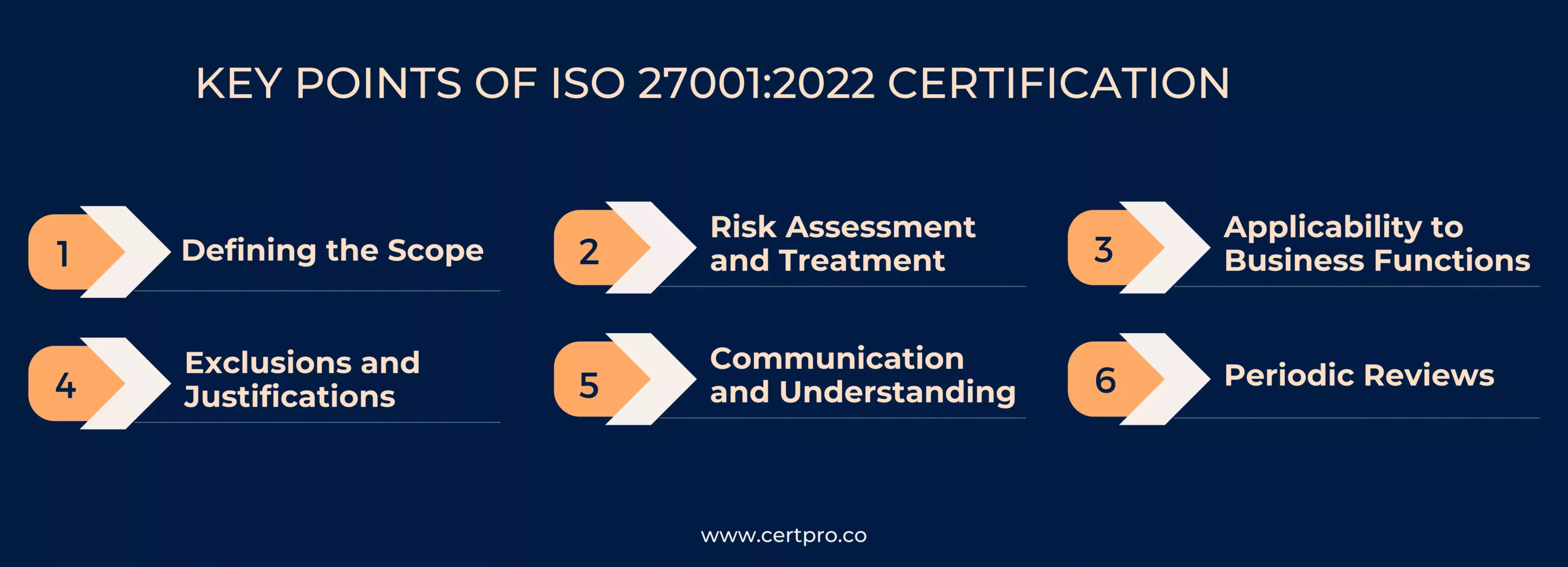
CHALLENGES FOR ISO 27001 : 2022 CERTIFICATION
This certification is a valuable achievement for organizations aiming to strengthen their information security practices and protect sensitive data. However, the certification process comes with several challenges that organizations commonly encounter.
Some of the common challenges for certification of ISO 27001:2022 are:
- Resource Constraints: Implementation requires significant resources, including financial investments and skilled personnel. Smaller Organizations or those with limited budgets may find it challenging to allocate adequate resources for the certification process.
- Complex Risk Assessment: Conducting a comprehensive risk assessment is a fundamental aspect of ISO 27001 compliance. However, many Organizations struggle with identifying and evaluating potential information security risks and their potential impacts on the business.
- Documentation Burden: It mandates detailed documentation of policies, procedures, and controls. Creating and managing this documentation can be overwhelming, particularly for organizations with limited experience in information security documentation.
- Resistance to Change: Introducing new security controls and practices may face resistance from employees who are accustomed to established workflows.
- Lack of Information Security Awareness: Insufficient awareness and understanding of information security practices among employees can hinder the successful implementation of the requirements.
- Maintaining Compliance: Earning this certification is a lifelong endeavor. Organizations must continuously monitor and update their ISMS to maintain compliance with the standard’s requirements.
BEST PRACTICES FOR ISO 27001 : 2022 CERTIFICATIONS
Implementing ISO 27001 successfully requires a systematic approach and adherence to best practices.
Some key best practices are:
1. Top Management Support: Obtain active support from top management to prioritize the ISO implementation. Leadership buy-in fosters a culture of information security throughout the organization.
2. Develop a Clear Roadmap: Create a comprehensive plan that outlines the steps and milestones required for certification. Allocate resources strategically and set realistic timelines for each phase of the implementation.
3. Conduct a Comprehensive Risk Assessment: Perform a thorough risk assessment to identify and evaluate information security risks, vulnerabilities, and potential impacts.
4. Adopt a Risk-Based Approach: Use a risk-based approach to prioritize security controls based on the severity and likelihood of potential risks. This ensures that resources are focused on addressing the most critical threats.
5. Involve Employees: Engage employees in the certification journey by providing information security training and awareness programs. Educate them about their roles in safeguarding sensitive information.
6. Establish Information Security Policies: Develop clear and concise information security policies that set the direction for the ISMS and guide employees in their security responsibilities.
7. Conduct Internal Audits: Regularly conduct internal audits to assess the effectiveness of the ISMS and identify areas for improvement. Internal audits help prepare for external certification audits.
8. Continual Improvement: Treat the certification as an ongoing journey. Regularly review and update the ISMS to keep up with evolving threats and changes within the organization.
9. Plan for Incident Response: Develop and implement incident response plans to handle information security incidents effectively. Conduct mock drills to test the efficiency of the response procedures.
10. Review Legal and Regulatory Compliance: Regularly review and update policies and controls to ensure compliance with relevant laws, regulations, and industry standards.
NEW VERSION OF ISO 27001 : 2022 CERTIFICATIONS
When ISO 27001 New Version 2022 is released, it usually includes the following types of changes:
1. Alignment with New Trends and Technologies: ISO 27001: 2022 Update The standard aligns with the latest trends and technologies in information security. It may address emerging threats, such as those related to cloud computing, the Internet of Things (IoT), or mobile devices.
2. Improved Risk Assessment and Management: The ISO 27001 New Version 2022 may refine the risk assessment process, including a more detailed evaluation of risks and their potential impact on the organization.
3. Enhanced Flexibility: ISO 27001:2022 update standards are often revised to provide organizations with more flexibility in implementing the requirements. This allows organizations to tailor their information security practices to their specific needs and risk appetite.
4. Integration with Other Management Systems: The ISO 27001:2022 update version may be more closely aligned with other ISO management system standards, facilitating integration with existing management systems, such as those for quality or business continuity.
5. Streamlining Documentation Requirements: ISO standards aim to simplify and streamline documentation requirements, making it easier for organizations to meet the standard’s requirements without excessive paperwork.
6. Consideration of Privacy and Data Protection: Given the increasing focus on data privacy, the new version may include additional considerations related to data protection and privacy laws.
Obtaining ISO 27001: 2022 certification may present challenges, but with proper planning and implementation of best practices, organizations can overcome these obstacles. The benefits of achieving certification, such as enhanced data protection, improved reputation, and increased customer trust, make the efforts worthwhile. Organizations that prioritize information security through this certification demonstrate their commitment to safeguarding sensitive information and staying ahead in an increasingly data-driven and interconnected world.
FAQ
WHAT ARE THE COMMON CHALLENGES IN ISO 27001: 2022 CERTIFICATION?
Meeting new standard requirements, gaining management commitment, resource allocation, integrating with existing processes, and maintaining ongoing compliance are typical challenges.
WHAT ARE THE BEST PRACTICES FOR ISO 27001: 2022? CERTIFICATION ?
Conduct a thorough gap analysis, involve all stakeholders, establish a risk-based approach, provide training, document processes, conduct regular audits, and continuously improve the Information Security Management System (ISMS).
HOW SHOULD A RISK ASSESSMENT BE CONDUCTED IN ACCORDANCE WITH ISO 27001?
Under ISO 27001, conducting a risk assessment involves identifying information security risks, evaluating their potential impact and likelihood, and prioritizing them.
HOW TO INTEGRATE ISO 27001 WITH OTHER MANAGEMENT SYSTEMS?
To integrate ISO 27001 with other management systems, identify common elements between standards, harmonize policies and processes, and streamline audits and resources.
WHAT ARE THE BENEFITS OF ISO 27001:2022 CERTIFICATION OVER THE PREVIOUS VERSION ?
Updates in new version are likely to address emerging security challenges, incorporate best practices, and provide a more robust framework to protect against evolving threats

About the Author
ANUPAM SAHA
Anupam Saha, an accomplished Audit Team Leader, possesses expertise in implementing and managing standards across diverse domains. Serving as an ISO 27001 Lead Auditor, Anupam spearheads the establishment and optimization of robust information security frameworks.
IS SOC 2 THE SAME AS ISO 27001?
In today's digital landscape, ensuring the safeguarding of client data is paramount for businesses. Adhering to recognized compliance standards is vital to meeting this demand. ISO 27001 vs. SOC 2 represent two prominent benchmarks in the realm of data security with...
WHO NEEDS ISO 27001 CERTIFICATION AND WHY?
The esteemed ISO 27001 security framework is designed to evaluate the effectiveness of an organization's Information Security Management System (ISMS) in safeguarding its data. Obtaining ISO 27001 certification is a practical way for a corporation to demonstrate its...
IS ISO 27001 RISK ASSESSMENT VITAL FOR SECURITY MEASURES?
The ISO 27001 standard provides a framework for information security, highlighting the importance of a thorough risk assessment procedure. Organizations use the methodical and complex ISO 27001 risk assessment process to identify and assess information security...

